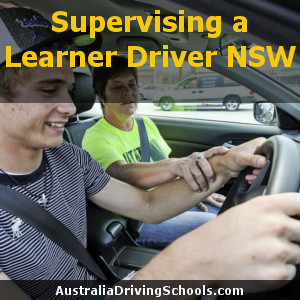Supervising a Learner Driver NSW
While many learner drivers get lessons from professional driving instructors, many will also want additional driving practice and some lessons from a family member, relative or a friend.
Person supervising a learner driver NSW must meet the following conditions:
- Hold a current full Australian driver licence – not a learner or provisional licence
- Have a good understanding of the road rules
- Be a competent driver
- Be able to effectively communicate information and ideas clearly.
The blood alcohol content (BAC) limit for you while you are supervising a learner driver NSW is under 0.05. It is also illegal to supervise under the influence of drugs.
Learner Driver Log Book
As the supervising driver, you will need to mark off the learner driver’s progress against a range of key tasks in their Learner Driver Log Book. The book also includes instructions on how to do this.
You are a role model supervising a learner driver NSW
You are both a mentor and role model for your supervised learner driver. You should support and guide them to become a safe and skilled driver. You will also need to be patient and calm.
It is a good idea to review your own driving skills and habits by:
- Reading the Road Users’ Handbook to familiarise yourself with current road rules
- Ensuring you comply at all times with traffic lights, signs and road markings
- Ensuring you leave plenty of space between your vehicle and the vehicle in front
- Looking well ahead and checking ‘blind spots’ and vision blockouts
- Driving at a suitable speed for conditions
- Responding appropriately to hazards
- Being patient and courteous with other drivers
- Reading the Learner Driver Log Book to understand the content and learning goals.
12 Tips To Supervising a Learner Driver NSW Better
Follow these tips when you are supervising your learner driver:
 If either you or the learner driver is tired, upset or stressed, reschedule the practice session to another time
If either you or the learner driver is tired, upset or stressed, reschedule the practice session to another time- Try frequent, short practice sessions in the beginning
- Use the Learner Driver Log Book task key points as a guide to practice sessions
- Begin with the easiest tasks then, once they have been mastered, move to the more difficult tasks
- Discuss then demonstrate new tasks before getting the learner to attempt them
- Use ‘commentary driving’ which involves the driver and passenger talking about what is happening inside and outside the vehicle
- Start the learner practising on quiet streets, preferably in daylight, before moving onto busier roads and more challenging conditions
- Allow the learner to proceed at his or her own pace
- Don’t criticise mistakes. Calmly discuss what happened and allow the learner to try again
- Be positive and offer praise when the learner successfully completes a task
- Emphasise the importance of developing a sensitivity to speed. They need to understand that the faster a vehicle travels, the more difficult it becomes to respond to potential hazards. When involved in a crash, the faster a vehicle is travelling, the more devastating the outcome
- Avoid using the radio, mobile phone or talking to other passengers while the learner is practising

 If either you or the learner driver is tired, upset or stressed, reschedule the practice session to another time
If either you or the learner driver is tired, upset or stressed, reschedule the practice session to another time